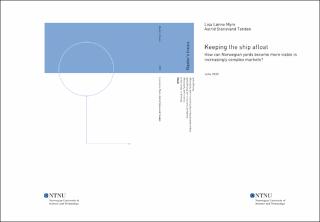| dc.contributor.advisor | Finnestrand, Hanne | |
| dc.contributor.advisor | Dreyer, Heidi Carin | |
| dc.contributor.author | Myre, Lisa Lønne | |
| dc.contributor.author | Tenden, Astrid Stensvand | |
| dc.date.accessioned | 2021-09-14T17:08:27Z | |
| dc.date.available | 2021-09-14T17:08:27Z | |
| dc.date.issued | 2020 | |
| dc.identifier | no.ntnu:inspera:59813597:59815533 | |
| dc.identifier.uri | https://hdl.handle.net/11250/2776978 | |
| dc.description.abstract | De norske verftene opplever for øyeblikket utfordringer knyttet til produktivitet og tap i lønnsomhet. Formålet med denne oppgaven er å utforske hvordan norske verft kan øke deres levedyktighet i markeder som blir mer og mer komplekse. Disse utfordringene er knyttet den økonomiske nedgangen i markedet siden finanskrisen i 2008, samt nedgangen i offshore-markedet i 2014, hvilket har ført til lavere markedsetterspørsel. Norske verft har beveget seg inn i ukjente farvann ved å posisjonere seg i markedssegment som cruise og offshore wind. Dette øker utfordringen knyttet til lønnsomheten, og det tar tid å strømlinjeforme nye verdikjeder. Verftene opererer i engineer-to-order verdikjeder som blir mer og mer komplekse, og det er ikke tilstrekkelig forskning om hvordan å styre disse. Ved å betrakte organisasjonen i sin helhet, og å analysere sammenhenger innad, kan sub-optimal ledelse bli unngått, hvilket kan lede til økt lønnsomheten for bedriften. Det er behov for en holistisk tilnærming for å forstå de hindrene for økt lønnsomhet og produktivitet som norske verft står ovenfor. Det er på dette grunnlaget at systemteori blir benyttet i denne oppgaven. Ved å anvende “Viable Systems Model” på et norsk verft, har det blitt pekt på flere brudd av levedyktighetsprinsipper.
Diagnosen av det norske verftet har identifisert åtte funn som har blitt diskutert med bedriftsrepresentanter. Disse funnene stammer fra tre overordnede brudd på levedyktighetsprinsippene. For det første må koordinasjonsfunksjonen til det norske verftet forbedres for å kunne takle informasjonsflyten. For det andre mangler de forskjellige operasjonene i bedriften autonomi. Dette krever omfattende koordinasjon av møteaktivitet, og påvirker den daglige beslutningstakingen. Til slutt er datterselskapene profitt-søkende, og har et forhold basert på forhandlinger. Dette ser ut til å hindre deres samarbeid i noen faser av skipsbyggingsprosessen.
Funnene indikerer at det eksisterer flere hindringer i levedyktigheten til norske verft, og denne oppgaven fungerer som en god basis for å diskutere disse. Oppgaven vil bidra til diskusjonen om hvordan å øke produktivitet og lønnsomhet i dagens utfordrende marked, ettersom at hindringene på levedyktigheten blir relatert til industrien rundt case-firmaet. Viable Systems Model har, så vidt vi vet, aldri blitt brukt på europeiske verft før, og det argumenteres derfor for at den kan bidra med ny innsikt til Viable Systems Model-verdenen. Med denne oppgaven er anvendbarheten og allsidigheten til Viable Systems Model bekreftet. | |
| dc.description.abstract | The Norwegian yards are currently experiencing issues with productivity and profitability losses. The purpose of this thesis is to explore how Norwegian yards can increase their viability in markets that are becoming increasingly complex. This is related to the general slowdown of the economy since the financial crisis in 2008, as well as the decline in the offshore market in 2014. The Norwegian yards have positioned themselves in new market segments, such as cruise and offshore wind. These segments are uncharted waters for them. This adds to the profitability challenge, as it is recognised that it takes time to streamline the new value chains. The yards operate with increasingly complex and entangled engineer-to-order supply chains, and the research on how to efficiently manage these is scarce. By examining a whole organisation and analysing how its entities are related, sub-optimal management can be avoided, and the profitability of the company as a whole can be increased. As there is a need for a holistic approach to understand what hinders the Norwegian yards in becoming more productive and profitable, systems theory provides the theoretical foundation for this thesis. By applying the Viable Systems Model on a Norwegian yard, insights on how viability principles are violated have surfaced.
The diagnosis of the Norwegian yard identifies eight discussion points that have been addressed with company representatives. These findings stem from three overarching viability violations. Firstly, the coordination function in the focal company should be improved to handle necessary information flow. Secondly, the lack of autonomy in operations seems to create extensive coordination efforts in meeting activities and affects the daily decision-making. Lastly, the subsidiaries of the focal company are profit seeking and have a bargaining relationship that seems to hamper their collaboration in some phases of the shipbuilding process.
The findings indicate that there are several hindrances to the viability of Norwegian yards. This thesis serves as a good basis to address them. The thesis ultimately adds to the discussion on how to increase productivity and profitability in today's challenging markets, as the viability violations that are identified can be related to the general industry. The Viable Systems Model has, to the best of our knowledge, never been applied to European shipyards before, and we therefore argue that the world of Viable Systems Model can gain new insights. With this thesis, the applicability and versatility of the viable systems theory is confirmed. | |
| dc.language | | |
| dc.publisher | NTNU | |
| dc.title | Keeping the ship afloat - How can Norwegian yards become more viable in increasingly complex markets? | |
| dc.type | Master thesis | |
